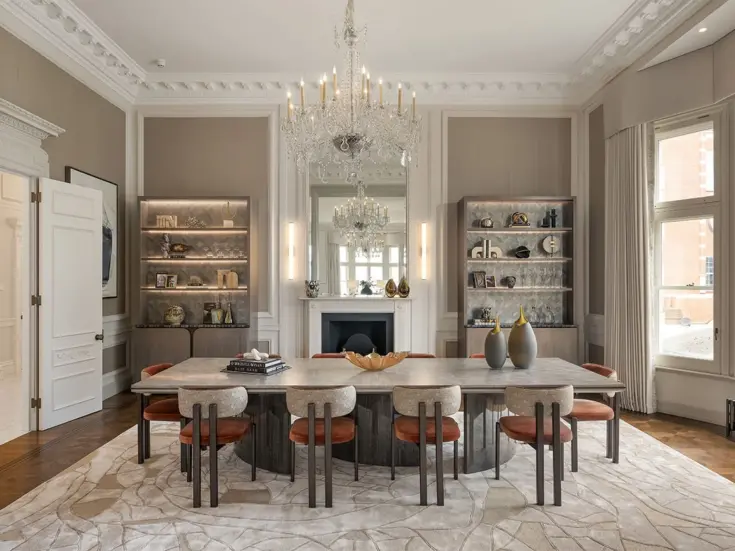
In With the Nouveau
Ross Clark on the relative decline in the value of period properties and the resurgence of interest in brand spanking shiny new homes in town and country alike
NEAR WHERE I live in East Anglia a large but rather ruffled Victorian hunting lodge recently came on to the market. It is a trophy house, you might think: the stuff of 1980s car adverts which liked to compare the finesse of German automobile engineering with the solid architecture of an English country house.
Had it come up for sale in that decade it would most likely have ended up a corporate HQ or management training centre. More recently, with levels of personal wealth so much higher than in the fabled decade of ‘greed and excess’, it would have been restored as a private home with helicopter pad.
Right now, however, it seems destined to end up in a local landfill site. It is on the market as a knock-down and rebuild — a £3.5 million demolition project. Plans for a replacement house — a low-slung flashy pavilion of glass and concrete — have already been passed by planners. After a generation spent mourning the lost country houses pulled down by their hard-up owners in the 1940s and 1950s, the bulldozers are revving up once more.
British homebuyers appear to be falling out of love with old houses. Only this time it isn’t so much a shortage of money that is doing for them — there is still plenty of that sloshing around at the top end of the market. It is a straightforward distaste for fusty old buildings.
It isn’t just country properties, either. Look around the priciest residential streets of west London and it might appear that little has changed. But behind the listed façades there is little remaining of many Georgian and Victorian properties: they have been entirely rebuilt with larger rooms, better soundproofing and more room for cabling and plumbing.
The relative decline in the value of period properties has been a remarkable though little commented-upon feature of the property slump. Until the credit crunch in 2007 British house-hunters, almost uniquely in the world, had a strong preference for living in houses which were at least a hundred years old. The average sale price for a new property in that year, according to the Halifax, was £226,714, while the average pre-1919 property sold for £259,534.
There was no question which had made the better investment over the previous quarter of a century: in 2007 the average new home was 5.35 times higher than its equivalent in 1983, while the price of a period home was 8.16 times higher.

A highly desirable old property, Chesworth House near Horsham in West Sussex
OVER THE PAST four years, however, older homes have suffered the worst of the slump. In the third quarter of 2011 the average new property sold for £208,774 and the average pre-1919 property £189,129. The price of inter-war homes has slid even more, from £245,278 in 2007 to just £122,323 in 2011.
Part of the reason the prices of new houses have stood up better is that housebuilders are concentrating on the upper end of the market, where buyers tend to have larger deposits or do not require mortgages at all. Nevertheless, estate agents throughout the south of England tell a similar a story: it is easier to sell a brand-new home than it is an old pile requiring work. Austerity seems to have turned us away from buying properties which we conceive might turn out to be expensive to run and harbour problems which could land us with a large bill.
A liking for living in old homes always did sit a little oddly alongside our preferences for other goods. Few of us choose to drive round in a creaking Austin Seven, listen to music on a wind-up gramophone and ring our friends on an old Bakelite telephone — we want the very latest in technology. There are people who collect classic cars, but they don’t use them every day: having taken the Jaguar E-Type for a run on a Sunday, they put it back in the garage and drive to work in the Lexus because it works better.
Houses, though, were for so many years a different story. We tolerated the damp and draftiness of an old house because we wanted to enjoy the charm. We liked to believe, not always supported by fact, that period houses were more solidly built than new ones. Inter-war houses are popular with buyers because they tend to be built on much larger plots than modern houses. Moreover, and perhaps most importantly, period properties tend to occupy prime locations in the centres of towns and villages.
But against the advantages of an old home are the greater running costs. The draftiness of an old house didn’t matter so much when fuel and power were cheap, but it does when electricity prices are up 15.5 per cent over the past twelve months and gas prices up 25.3 per cent. That said, the difference in energy efficiency between old and new homes is not as great as many people imagine. Data from the Department for Energy and Climate Change show that the pre-1919 homes consumed an average of 18,360kWh of gas and 4,928kWh of electricity in 2008. Homes built after 2000 used an average of 16,971kWh gas and 4,402kWh electricity.
ANOTHER IMPORTANT FACTOR in the declining demand for old properties is the tedium of renovation. It is not just a question of cost. Restoring an old house can be a drawn-out business which consumes years of meetings with builders and negotiations with planners. It can mean taking on an extra job in your spare time. That was one thing in the 1980s, but the wealthy tend to work harder on their day jobs nowadays. Moreover, they have more international lifestyles based around commuting from one property to another.
Combined with that is the improving image of new housing. Back in the 1980s there were no two words in the English language more depressing than ‘new house’. But after a decade of Grand Designs a brand-new home is now something to which to aspire. It will be a while before the wrecking ball moves into Blenheim Palace, but homes are becoming just like any other consumer goods. We want the latest new model, not a relic from 1740. And when it starts to creak and whine, and the planners will possibly let us get away with it, we are not afraid to bin it.
Read more by Ross Clark
Don’t miss out on the best of Spear’s articles – sign up to the Spear’s weekly newsletter
[related_companies]







